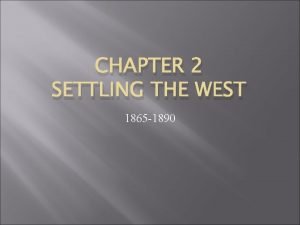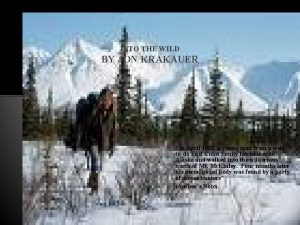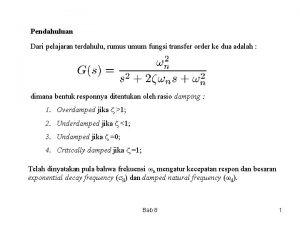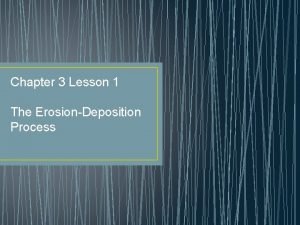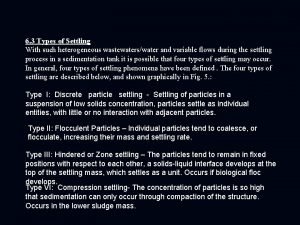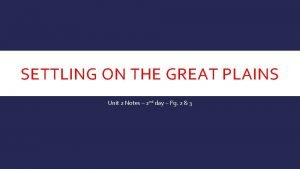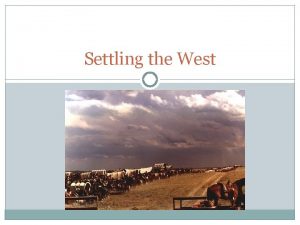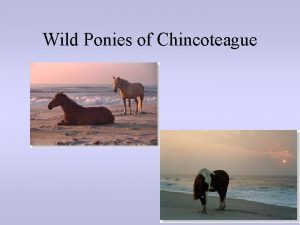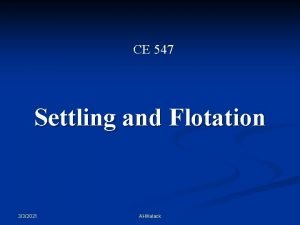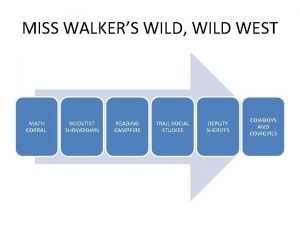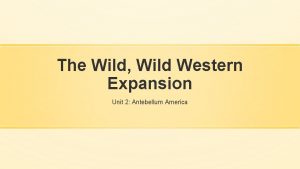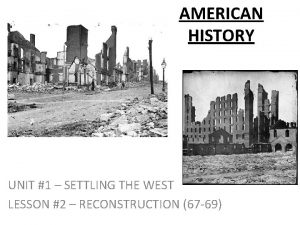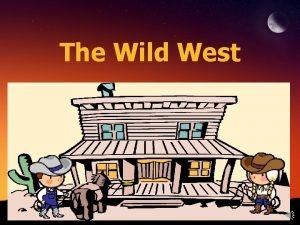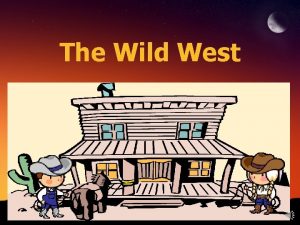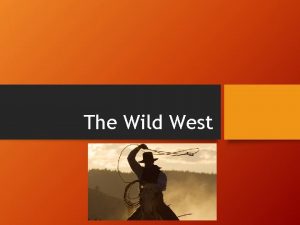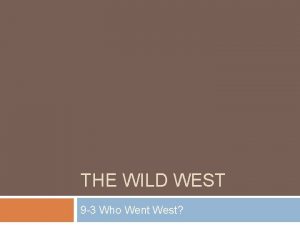Unit One The Wild West Settling the West






















- Slides: 22

Unit One: The Wild West Settling the West

Westward Expansion • From the beginning of American history, Americans were constantly moving westward expanding the boundaries of the country and to gain their own land or sense of independence. • This constant wave of settlers led to regular conflicts with Native tribes who lived in the areas. • The Americans first moved across the Great Plains to the Pacific Coast because it was thought to be a vast desert, but American settlers starting just before the Civil War began closing in the Great Divide.

Indian Territory • The Great Plains also known as the Prairies (a vast rolling grassland) was a sparsely populated vast amount of land in the center of North America. • The Great Plains was “given” to the Indians by the American government as a reserve known as the Indian Territory. • The Plains were populated by the Plains Indians which included the Arapaho, Sioux, Cheyenne, Pawnee, and Navajo.

Indian Territory • The Plains Indians due to the introduction of the horse by the Spanish became expert breeders and riders with all aspects of their society based around their Horse Culture. • The horse made the Plains Indians extremely mobile nomadic hunters. • The Plains Indians hunted the American Buffalo, which was used for food, housing (teepee), clothing, medicine, and as part of their religion.

Indian Territory • The Plains Indians were not the only Indians who lived in the region, due to the Indian Removal Acts (1830) of Andrew Jackson’s administration most all Eastern tribes were moved across the Mississippi into the Oklahoma Territory (Plains). • The greatest example of this forced movement was the Trail of Tears when the Cherokee Indians were forced out of Georgia to the Oklahoma Territory.

Indian Territory • The Natives of the Plains heard of the American white man from the Eastern tribes, but already new about the “white man” when the Spanish owned the territory. • The Great Plains or “Western frontier” would not stay long in the hands of the Natives due to the movement of miners, ranchers, homesteaders, and railroads into the area to claim it for American prosperity.

Manifest Destiny • Americans believed through Manifest Destiny that it was America’s mission from God to spread over the whole of the continent and settle the land. (no matter who was in the way) • The American government just before the Civil War tried to entice settlement into the Great Plains region and railroad expansion across the continent to the Pacific Ocean to connect the nation.

Western Expansion • There were many push-pull factors leading to settlement of the West. – Push – displacement of farmers, former slaves, and other workers after the Civil War; mass immigration into the Eastern seaboard; high cost of living in the East. – Pull – government incentives through various acts offering large tracts of land for cheap prices; owning own land (private property); gold strikes; vast amount of cattle and buffalo.

Government Incentives • The Pacific Railway Acts of 1862 & 1864 gave large land grants to the Union and Central Pacific Railroads for the purpose of the building of a Trans-Continental Railway or Overland Route. (They received more than 175 million acres of public land). • The Union Pacific started at Omaha Nebraska and was built mostly by Irishmen (patty or mick), veterans, and free blacks. • The Central Pacific started just south of San Francisco, California and was built mostly by Chinamen (chink, celestials, or coolies) and Native Americans.

Transcontinental Railroad • The construction was hard with tunnels having to be blasted into the Sierra Nevada Mountains with the use of nitroglycerin (liquid explosive). • The final spike (golden spike) was driven on 10 May, 1869 at Promontory Point Utah. (“Driven” by Leland Stanford president of the Central Pacific”) • The driving of the Golden Spike signaled the completion of Manifest Destiny and led to mass settlement of the Great Plains region.

Transcontinental Railroad • To better organize the train routes and time schedules the railroads adopted A System of National Time Zones for Railroads, dividing the nation into four time zones.

Government Incentives • The Morrill Land-Grant Act of 1862 gave state governments millions of acres of land in the West to sell for the establishment of “Land Grant” colleges for agriculture and mechanical arts. (Auburn and Alabama A&M) • The largest amounts of these lands were purchased by bankers and land speculators (people who bought land in the hope that the price would rise and sell it for a profit later. ) • The Homestead Act of 1862 offered people 160 acres of land (quarter mile square) for a dollar an acre if they lived and cultivated the land for five years, it was free.

Government Incentives • The Timber Culture Act of 1873 provided a free grant of 160 acres of land if forty acres were planted in trees, for ten years. • The Desert Act of 1877 provided for 640 acres of land for a dollar an acre to reclaim, irrigate, and cultivate the land for three years. • These many incentives caused people in mass numbers to settle the Western lands, but the first mass wave of people developed because of the gold strikes.

The Mining Strikes • There are two types of mining: placer and quartz. – Placer mining is when dirt from river beds is sifted for gold, or small mines are dug into mountains. (panning or using a sluice box) – Quartz mining is done by deep mines dug into the ground or mountain sides by large mining corporations. • A person who came to the west to hunt for gold was called a prospector. • A prospector “staked” a “claim” on his land had to protect it from others, because if he left it he lost the claim. (later claims were bought and sold)

Mining Techniques

The Mining Strikes • The first gold strike that moved people to the West in great numbers was the discovery of gold on Sutter’s Mill sparking the California Gold Rush and the mass movement of single men called Forty-niners (1849) into the area. • The next major gold strike was the Colorado Gold Rush in 1859 at Pike’s Peak by William Greenberry Russell near Cherry Creek. • Many people headed to the area with the slogan “Pike’s Pike or Bust”, but many did not find gold, because it was too deep.

The Mining Strikes • Also in 1859 a huge silver and gold strike developed in Nevada’s Six-Mile Canyon by “Henry Comstock” with his famous Comstock Lode. ( It was one of the richest silver veins in the world with $306, 000 worth of bullion. ) • John W. Mackay and partners found the largest vein of ore in the Comstock Lode known as the “Big Bonanza”. • During the Civil War gold strikes and rushes occurred in Idaho, Montana, Washington, Wyoming, and New Mexico.

The Mining Strikes • In the 1870 s a gold strike was found in the Black Hills of the Dakota Territory by a group of prospectors led by George Armstrong Custer starting the Black Hills Gold Rush. • One of the biggest effects of the Black Hills Gold Rush was the encroachment on Sioux Indian lands and war. • The last great gold strike was in the 1890 s in Alaska known s the Klondike or Yukon Gold Rush. (Last Frontier)

Effect of the Mining Strikes • The quick rush of people into the mining areas led to quickly put together towns known as Boom towns. • When the gold, silver, copper, or etc. veins went dry so did the town, now called a ghost town. • In the West famous and infamous mining towns developed like Tombstone, Deadwood, Last Chance Gulch, Leadville, Silver City, and Virginia City. • Most all Boomtowns had a Saloon (casino and bar), Hurdy-gurdy House/brothel/bordello (prostitutes), Opium din, Race track, and General Store.

The Mining Frontier

Effect of the Mining Strikes • The mining towns were at times violent places to live with prospectors fighting over claims, highway men or road agents attacking stagecoaches that carried goods and precious metals, and town violence. • To enforce the law because organized law was scarce or corrupt, miners and townspeople formed vigilance committees to track down criminals and hang them by lynching (lynch mob justice). • A new style of dress developed in the mining areas led by Levi Strauss who in 1872 with inventor Jacob Davis patented denim “blue” jeans to sell to the miners.

Effect of the Mining Strikes • People in these areas before the expansion of the railroads got their mail through the Pony Express. • One of the most famous stagecoach services was Wells Fargo & Co. formed by the founder of American Express (pony mail service) Henry Wells, William Fargo, and John Warren Butterfield. • The Mining Frontier led to mass movements of people into the Western Frontier and gave needed capital and materials for the Industrial boom in America.
 Chapter 2 settling the west
Chapter 2 settling the west Settling the west part 2 packet- farming the plains
Settling the west part 2 packet- farming the plains Wild born
Wild born Wild sweet pea vs wild potato
Wild sweet pea vs wild potato Wild west geography
Wild west geography Primary settling
Primary settling Settling velocity stokes law
Settling velocity stokes law Is terminal velocity constant
Is terminal velocity constant Differential settling method
Differential settling method Floating and settling examples
Floating and settling examples Rumus fungsi transfer
Rumus fungsi transfer Esp electrodes
Esp electrodes Clarifier tank design
Clarifier tank design Damping ratio in control system
Damping ratio in control system Input system output
Input system output Wesam al madhoun
Wesam al madhoun Control systems overshoot
Control systems overshoot What is the laying down or settling of eroded material?
What is the laying down or settling of eroded material? Gravitational settling chamber
Gravitational settling chamber Settling types
Settling types Terminal velocity formula
Terminal velocity formula An ideal horizontal flow settling basin
An ideal horizontal flow settling basin Settling on the great plains section 2
Settling on the great plains section 2
